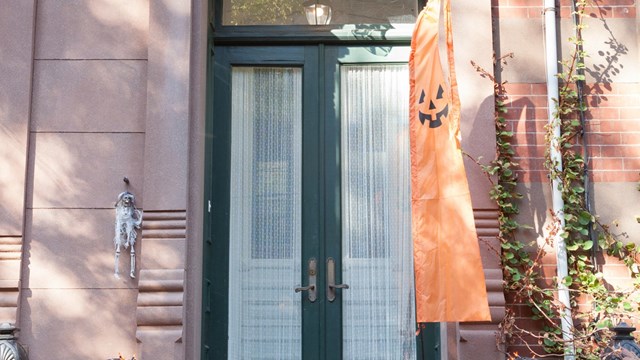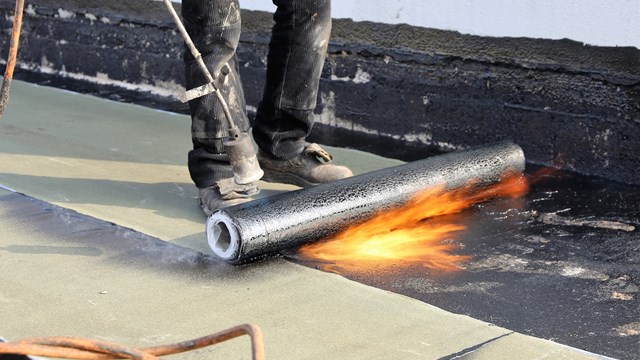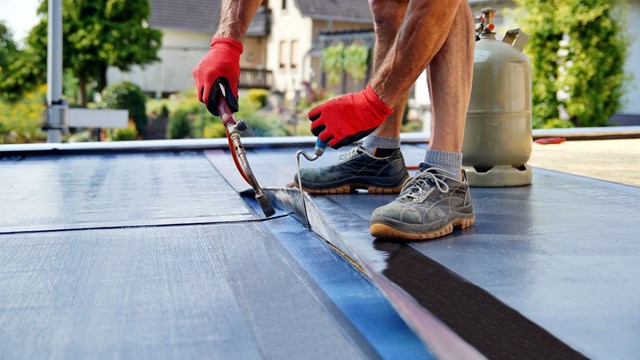Good quality windows are essential to a building's aesthetic appeal, as well as its energy efficiency. But what is involved in changing out the old windows for the new? There are a few important things boards and managers should know about the process of a complete window replacement project for their building, be it a high-rise, a townhome, or a more spread-out condominium association.
Windows Don't Last Forever
Old windows can be a bear to put up and down, a nuisance to clean, and an extreme drain on our energy bills. But what are the signs of seriously deteriorating windows?
Decide whether or not the windows are still functional, suggests Joel Cuccio, president of American Jewel Window Systems in Lodi. Do they raise and lower properly, are the springs still working, and is the weather stripping worn to the point of leaking air?
"There's a maintenance factor to consider when windows have to be painted, if they're wood windows," Cuccio says. Instead of painting, "a homeowner might want to consider a total solution to improving thermal performance and energy loss. Just caulking [and painting] an existing window may not achieve that."
Cuccio mentions that the term is "energy loss," not just "heat loss," bringing up the point that your apartment can leak air conditioning through poor windows, too.
"Sometimes the alignment—the point where the two sashes join and meet each other—is off-skew," warns Tom Mazzoni, a 25-year veteran in the window business and an architectural sales representative for New Jersey Window Erectors in Sparta. "What happens is the sashes don't meet up—and that becomes a security problem as well as an air infiltration problem."
"Wood windows that have not been properly maintained will begin to flake paint and the putty will begin to dry-rot," says Michael Mastroberti, president of Window City, Inc., in Clifton. "Over time, wood will continue to dry out, causing shrinkage, and this condition will allow air infiltration around the sash frames along with 'window rattle' on windy days."
What are the primary factors contributing to window deterioration? Experts agree that lack of maintenance, poor installation, improperly manufactured products, and just plain use will all contribute to a window needing replaced.
As for what you can expect in terms of lifespan of your windows, it depends on a variety of factors. Mazzoni says a properly-maintained wood window will last a homeowner 20 to 25 years, while a properly maintained aluminum-clad window will last about 20 to 30 years. A window that has an aluminum exterior and a wooden interior will give you 25 to 30 years of use, and aluminum or vinyl windows have a good 30 or 40 years in them, if they're properly maintained.
Changing Technology
"It goes back to the same thing," says Cuccio, whose third-generation company has been manufacturing vinyl window systems since the late 1970s. "How was it manufactured, what was it designed to do, how was it engineered? It may not necessarily be deteriorating, but it may not be doing its job because it lacks the state-of-the-art weather stripping that window products have today. So it's not just age, it's also design."
Window design and manufacturing have changed dramatically over the past 10 or 20 years. So-called "Low-E" coated glass and argon/krypton gas are major innovations. Low-E, a metallic coating, allows the sun's rays to enter the home during the winter months but blocks them during the summer months based on the long and short rays emitted by the sun.
Argon and krypton gases are sometimes inserted into gap between two panes of insulated gas, which has an exterior as well as an interior surface. Mastroberti explains that the temperature difference between the two panes causes the air and gas sandwiched in between "To rotate, thus causing temperature transmission. This cycle can be very rapid, and the more rapid, the quicker the conduction. The heaviness of argon and krypton slow the rotation of air to almost nothing, keeping the extreme exterior temp from being conducted to the interior."
"Window technology has changed tremendously," agrees Cuccio, whose firm serves the New York, New Jersey, Delaware, Maryland, and Pennsylvania markets. "Vinyl revolutionized the window industry. Vinyl is a material that does not conduct heat or cold, so there is no loss of heat or cold through the vinyl material itself."
"The technology of windows today is one thousand percent different than it was 20 years ago," adds Mazzoni.
The Process
After you decide it's time to embark on a full-fledged window replacement project for your building or HOA, you should first do some research, then make sure you evaluate what it is you're trying to accomplish by getting new windows. Is it primarily improved aesthetic value you're after, or do you have more of an energy efficiency objective?
"Typically, the reason for replacing windows concerns energy savings, but other factors including operation and curb appeal are just as important," explains Mastroberti, whose firm specializes in multi-family and commercial window replacement projects throughout the United States.
Once you do your preliminary research, the next best step is to talk to experts.
"Our sales engineers will scope a project to determine what best fits the application for any particular building and streamline the process," says Mastroberti. "Factors considered in this determination are the existing windows types and operation, building code requirements for height/egress/energy efficiency, and, naturally, color schemes that best fit your building's façade. Once this is established, a cost estimate is determined and discussed with the prospective customer."
"You need accurate measurements, a quality product, and a quality installation," advises Cuccio. "If you have those three ingredients, then you'll have a good project."
Consider the Timing
If you're considering a window project, now is the time to start the process. If you book your contractor now, you'll be more likely to get a reasonable lead time and a good price.
Although it is possible to do a window project during the winter months, it's not advisable, since temperatures below forty degrees make it difficult to ensure that window caulking will seal and adhere properly, says to Mazzoni.
Cuccio says his manufacturing time is two weeks and that installation takes about one day per ten windows.
"Of course, if this is an apartment building, then larger crews are usually put on to a greater output," he says. "Two installers can do 10 to 15 windows per day."
"Now is a great time to order, because manufacturers are still flexible in pricing," he adds. "They're not up to capacity, but you can still get a spring installation."
If your building is a historic or landmarked property, know that your project could be held up by extra regulations.
"Some areas require an exact replication in most areas where paint is scraped to determine the original color, and like materials must be used—i.e., existing wood casements require new wood casements," warns Mastroberti. "One can only respect the fact that they want to preserve a building's integrity and reflection of the past, but the process can be tedious and time-consuming."
If you're not dealing with a historic property, how long can you expect the entire process to take?
"Best-case scenario, if we're talking from the day of site evaluation: four to five months for a building," says Mazzoni. "We're talking two to four weeks for the shop drawings, and once these are completed and approved, it will be another six to eight weeks for delivery."
Mastroberti agrees with this timeframe. "In a high-rise, manufacturers tend to have a six to 12-week backlog on product, so three or four months advance notice may be necessary."
"In light commercial aluminum and vinyl window applications, four to six weeks is usually enough time to install samples, procure product, set up delivery times, notify residents, and commence installation," he adds.
Challenges and Disruptions
Although residents may look forward to new windows, they may still have to deal with some challenges and/or disruptions during the project.
Windows are generally installed from the interior of the home, although workers will work on both the inside and the outside at various points of the installation. If residents have a problem with installers coming into their apartment, then it is possible to do some of the work from the outside, but "it's a lot simpler to do it from the inside," says Mazzoni.
Even though residents may look forward to having new windows, they still may be concerned about noise, dust, and drafts. A good communication system is essential to setting residents' minds at ease and making the process as painless as possible.
"We like to have one or two open meetings where residents can ask questions and voice concerns, which starts the process of trust between contractor and customer," explains Mastroberti. His firm will notify residents and then set a specific appointment 48 hours in advance, along with a checklist of things they can do to prepare their home for contractors.
Mastroberti says one window takes about two to four hours, and during that time, "The home may get a little drafty in colder seasons. Dust is a factor but our crews cover the floors with drop cloths and paper then vacuum the entire area with HEPA vacuums."
"The biggest obstacle we deal with is window treatments," says Mazzoni. "If the tenants or owners don't want them disturbed, then we work around them if we can. As much as we can, we will take them down."
"Generally, if a condo or co-op building has a good board of directors and everybody's on board with replacing the windows, the process usually goes pretty smoothly," says Cuccio.
What Are the Costs?
Prices for new windows for your building will vary, depending on how many windows you need, the size of your openings, and the quality and style of windows you choose.
"A ballpark estimate using basic double-hung in white with no options: for a basic 100 units, aluminum would be $22,500, while vinyl would be $18,500," states Mastroberti. "But this could vary exceedingly because windows cost is based on size and installation application," he adds.
While these suggested numbers are for basic windows and installation, Mastroberti offers a very approximate cost of $90,000 for a state-of-the-art window replacement on 100 units that would include a fiberglass window with Triplepane Low-E glass and argon gas.
Depending on your budget and your association's look, a window replacement project can be quite an undertaking—but if your windows are beginning to show their age and aren't up to the job any longer, waiting to replace them could cost you and your HOA thousands in increased energy bills and security risks. With some planning and plenty of good communication between board, management, and residents, your window replacement project can be a win-win situation for everyone involved.
Domini Hedderman is a freelance writer living in Erie, Pennsylvania.







Leave a Comment